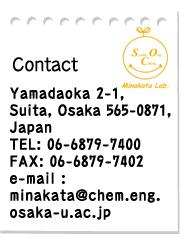
2025
2024
2023
2022
2021
2020
2019
2018
2017
2016
2015
2014
2013
2012
2011
2010
2009
2008
1998–2007
“Enantioselective Electrophilic Cyanation of Boron Enolates: Scope and Mechanistic Studies"
Takaya Nagata, Atsuko Tamaki, Kensuke Kiyokawa*, Ryosuke Tsutsumi, Masahiro Yamanaka*, and Satoshi Minakata*
Chem. Eur. J. 2018,
24, 17027–17032.
DOI:10.1002/chem.201804455
*Selected as a "Hot Paper"!

*Selected as the "Inside Cover" of the issue!

Abstract: Enantioselective electrophilic cyanation of boron enolates, which are readily prepared from α,β-unsaturated ketones and diisopinocampheylborane (Ipc
2BH), has been developed to afford chiral β-ketonitriles with a high level of enantioselectivity. The present method is scalable and provides facile access to both enantiomers of chiral β-ketonitriles. Analysis of the in-situ generated boron enolates by NMR revealed that the hydroboration proceeds in a stereospecific manner, providing α,α-disubstituted boron enolates in the form of a single isomer. Furthermore, the results of DFT calculations suggest that the cyanation of the boron enolates with
p-toluenesulfonyl cyanide (TsCN) proceeds in a highly enantioselective manner via a unique six-membered ring transition state.
“Syntheses of Diberse Donor-Substituted Bisbenzofuro[2,3-b:3',2'-e]pyridines (BBZFPys) via Pd Catalysis, and Their Photophysical Properties"
Yuhei Itai, Yuji Nishii, Patrycja Stachelek, Przemyslaw Data*, Youhei Takeda*, Satoshi Minakata, and Masahiro Miura*
J. Org. Chem. 2018,
83, 10289–10302.
DOI:10.1021/acs.joc.8b01451

Abstract: A series of bisbenzofuro[2,3-
b:3′,2′-
e]pyridines (BBZFPys) bearing a chlorine functionality have been efficiently synthesized through a Pd-catalyzed double oxidative intramolecular C–H/C–H coupling of monochlorinated 2,6-diaryloxypyridines. The subsequent Buchwald–Hartwig amination of the chlorinated BBZFPys allowed for the access to a new class of donor–acceptor (D–A) π-conjugated compounds that comprise BBZFPy as an electron acceptor (A) and diarylamines as a donor (D) unit. The investigation of the steady-state photophysical properties of the prepared D–A compounds revealed that they are emissive in both solution and solid states in the blue-to-green color region. The singlet–triplet energy splitting (ΔE
ST) was found to be much smaller than that of substituent-free BBZFPy (0.70 eV), ranging from 0.01 to 0.56 eV. The time-resolved spectroscopy revealed that the D–A compounds, comprising a bis(
tert-butyl)carbazole as the D and CF
3-attached BBZFPy as the A, showed delayed fluorescence (DF) in nonpolar matrix host material (Zeonex), while in a polar matrix (DPEPO), room-temperature phosphorescence (RTP) was faintly observed. Furthermore, organic light-emitting diodes (OLEDs) fabricated with the D–A compounds as a blue emitter showed a moderate external quantum efficiencies (EQEs) up to 1.5%.
“C–H Oxygenation at Tertiary Carbon Centers Using Iodine Oxidant”
Kensuke Kiyokawa*, Ryo Ito, Kenta Takemoto, and Satoshi Minakata*
Chem. Commun. 2018,
54, 7609–7612.
DOI:10.1039/C8CC03735C

Abstract: An oxidation system in which iodic acid (HIO
3) is used as an oxidant in the presence of
N-hydroxyphthalimide (NHPI) permitted the selective hydroxylation of tertiary C–H bonds and the lactonization of carboxylic acids containing a tertiary carbon center. These reactions are operationally simple and proceed under metal-free conditions using commercially available reagents, thus offering an ideal tool for the efficient oxidation of C–H bonds at tertiary carbon centers.
"Conformationally-Flexible and Moderately Electron-Donating Units-Installed Donor-Acceptor-Donor Triad Enabling Multicolor-Changing Mechanochromic Luminescence, Thermally Activated Delayed Fluorescence, and Room- Temperature Phosphorescence"
Youhie Takeda*, Takahito Kaihara, Masato Okazaki, Heather Higginbotham, Przemyslaw Data*, Norimitsu Tohnai, and Satoshi Minakata
Chem. Commun. 2018,
54, 6847–6850.
DOI:10.1039/C8CC02365D
*Open-access Article!
*Invited Article as a part of the themed collection "2018 Emerging Investigators"!
*Prof. Takeda was selected as an Emerging Investigator 2018!

Abstract: A novel twisted donor–acceptor–donor (D–A–D) π-conjugated compound that contains flexible and moderately-electron-donating units has been designed and synthesized. It exhibited not only multi-color-changing mechanochromic luminescence and thermally activated delayed fluorescence, but also, unexpectedly, room-temperature phosphorescence in a host layer.
"Hypervalent Iodine(III)-Mediated Decarboxylative Acetoxylation at Tertiary and Benzylic Carbon Centers"
Kensuke Kiyokawa*, Daichi Okumatsu, and Satoshi Minakata*
Beilstein J. Org. Chem. 2018,
14, 1046–1050.
DOI:10.3762/bjoc.14.92
*Open-access Article!
*This article is part of the Thematic Series "Hypervalent iodine chemistry in organic synthesis"!

Abstract: The decarboxylative acetoxylation of carboxylic acids using a combination of PhI(OAc)
2 and I
2 in a CH
2Cl
2/AcOH mixed solvent is reported. The reaction was successfully applied to two types of carboxylic acids containing an α-quaternary and a benzylic carbon center under mild reaction conditions. The resulting acetates were readily converted into the corresponding alcohols by hydrolysis.
"FRET-Mediated Near Infrared Whispering Gallery Modes: Studies on the Relevance of Intracavity Energy Transfer with Q-Factor"
Osamu Oki, Soh Kushida, Annabel Mikosch, Kota Hatanaka, Youhei Takeda, Satoshi Minakata, Junpei Kuwabara, Takaki Kanbara, Thang Duy Dao, Satoshi Ishii, Tadaaki Nagao, Alexader Kuehne, Felix Deschler, Rchard Friend, and Yohei Yamamoto*
Mater. Chem. Front. 2018,
2, 270–274.
DOI:10.1039/C7QM00498B
*Invited Article as a part of the themed collection "Pi conjugated system bricolage (figuration) toward functional organic molecular systemms"!

Abstract: Near infrared (NIR) optical microsphere resonators are prepared by coassembly of energy-donating and accepting conjugated polymers. In the microspheres, fluorescence resonance energy transfer occurs, leading to sharp and periodic photoluminescence from whispering gallery modes in the NIR region with Q-factors as high as 600.
"Recent Advances in the Synthesis of β-Ketonitriles"
Kensuke Kiyokawa*, Takaya Nagata, and Satoshi Minakata*
Synthesis 2018,
50, 485–498.
DOI:10.1055/s-0036-1589128
*Short Review!

Abstract: β-Ketonitriles are an important class of compounds in the field of organic and medicinal chemistry. Over the past decades, numerous efforts have been devoted to the development of new and efficient methodologies for the synthesis of these derivatives, and a number of efficient methods to accomplish this have been developed in recent years. In this context, this short review highlights recent advances in the synthesis of β-ketonitriles.














